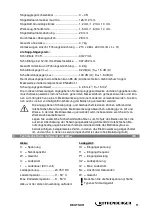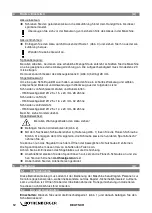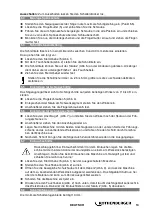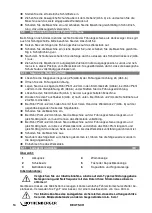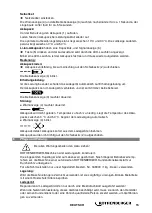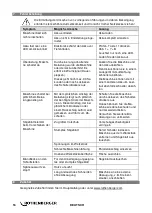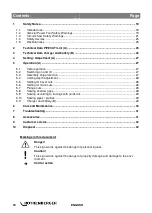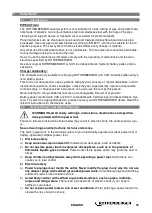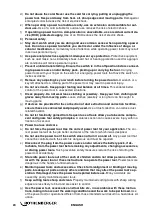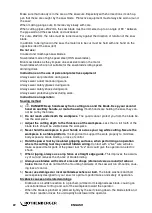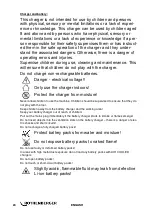
22
ENGLISH
Make sure that nobody is in the area of the saw cuts. Especially with short sections it can hap-
pen that these are caught by the saw blade. Protective equipment must always be worn around
the saw!
When making plunge cuts, immerse very slowly with care.
When cutting pipes> Ø42mm, the saw blade must be immersed up to an angle of 90 ° between
the pipe wall and the saw blade and advanced.
For cuts> Ø42mm, the tube must be turned evenly against the direction of rotation of the saw
blade.
In addition to being fixed in the saw, the material to be cut must be held with one hand on the
opposite side of the saw (left).
Do not use:
Cracked and misshapen saw blades.
Saw blades made of high speed steel (HSS saw blades).
Blunt saw blades as they impose an excessive load on the motor.
Saw blades which are not suitable for the saw blade's idling speed.
Grinding discs
Instructions on the use of personal protective equipment:
Always wear ear protectors during work.
Always wear a dust mark during work.
Always wear safety glasses during work.
Always wear safety shoes during work.
Always wear protective gloves during work.
Instructions on operation:
Verwenden Sie immer die mit
Sawing method
a)
DANGER: Keep hands away from cutting area and the blade. Keep your second
hand on auxiliary handle, or motor housing.
If both hands are holding the saw, they can-
not be cut by the blade.
b)
Do not reach underneath the workpiece.
The guard cannot protect you from the blade be-
low the workpiece.
c)
Adjust the cutting depth to the thickness of the workpiece.
Less than a full tooth of the
blade teeth should be visible below the workpiece.
d)
Never hold the workpiece in your hands or across your leg while cutting. Secure the
workpiece to a stable platform.
It is important to support the work properly to minimise
body exposure, blade binding, or loss of control.
e)
Hold the power tool by insulated gripping surfaces, when performing an operation
where the cutting tool may contact hidden wiring.
Contact with a "live" wire will also
make exposed metal parts of the power tool "live" and could give the operator an electric
shock.
f)
When ripping, always use a rip fence or straight edge guide.
This improves the accura-
cy of cut and reduces the chance of blade binding.
g)
Always use blades with correct size and shape (diamond versus round) of arbour
holes.
Blades that do not match the mounting hardware of the saw will run off-centre, caus-
ing loss of control.
h)
Never use damaged or incorrect blade washers or bolt.
The blade washers and bolt
were specially designed for your saw, for optimum performance and safety of operation.
Kickback causes and related warnings
-
Kickback is a sudden reaction to a pinched, jammed or misaligned saw blade, causing an
uncontrolled saw to lift up and out of the workpiece toward the operator.
-
When the blade is pinched or jammed tightly by the kerf closing down, the blade stalls and
the motor reaction drives the unit rapidly back toward the operator.
Summary of Contents for 1000003165
Page 415: ...NOTES ...




